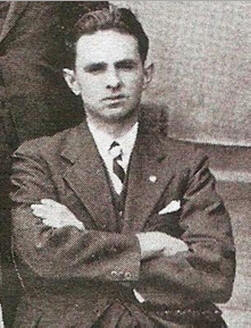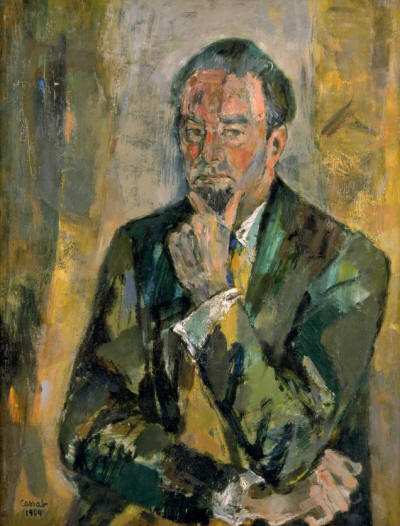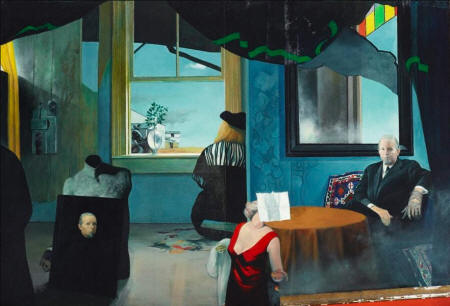 Mervyn Emrys Rosser Horton (27 July 1917 – 1 February 1983) was an Australian art editor, art collector and philanthropist.[1]
Mervyn Emrys Rosser Horton (27 July 1917 – 1 February 1983) was an Australian art editor, art collector and philanthropist.[1]
Queer Places:
L'Aiglon, 278 Glebe Point Rd, Glebe NSW 2037, Australia
Galleria Espresso, 27 Rowe St, Sydney NSW 2000, Australia
34-36 Victoria St, Potts Point NSW 2011, Australia
73 Pacific Rd, Palm Beach NSW 2108, Australia
13 Bay St, Double Bay NSW 2028, Australia
Christopher Davis Antiques, 12 Wentworth St, Paddington NSW 2021, Australia
 Mervyn Emrys Rosser Horton (27 July 1917 – 1 February 1983) was an Australian art editor, art collector and philanthropist.[1]
Mervyn Emrys Rosser Horton (27 July 1917 – 1 February 1983) was an Australian art editor, art collector and philanthropist.[1]
Mervyn Emrys Rosser Horton was born on 27 July 1917 at L’Aiglon 278 Glebe Point Rd, Glebe, Sydney, only child of Harry Horton, an English chartered accountant, and his Welsh wife Ethel Mabel Harris. Harry was involved in developing the local builders’ hardware firm Traversi Jones Pty Ltd, in which he soon became a major shareholder. Mervyn was often seriously ill as a child. He grew up as a Baptist and attended the Methodist Newington College, where for five or six years he edited the school magazine. The family spent 1936 in Europe and attended the Berlin Olympic Games. On his return Horton sent articles to the Sydney Morning Herald; they were rejected but he was offered a job there. His strict father insisted on his studying medicine instead but, after Horton spent an unhappy year at the University of Sydney, allowed a shift to law. Horton was articled to a city firm of solicitors; he abandoned the law with relief after his father died in 1940. Traversi Jones became his major source of income. Following repeated rejections for war service on physical grounds, and a nervous breakdown, work with the photographer Olga Sharpe provided convalescent therapy. In 1945-48 Horton was an assistant to the modernist commercial photographer Max Dupain.
After eighteen months in Britain, in 1951 he was appointed by Sam Ure Smith to replace Gwen Morton Spencer as publisher’s editor at Ure Smith Pty Ltd; he was also made a director. Ure Smith handed over to him the small jobs of secretary to the Society of Artists and gallery manager of its annual exhibitions and Horton was thereby launched into the Sydney art world. Contemporary art began to keep company with the antique furniture and silver he had enjoyed since childhood. The artist and art critic Wallace Thornton was a forceful mentor. `Outraged’ by Horton’s conservative and closeted lifestyle, he began to convert him into a bon viveur.

MERVYN HORTON
1964
Judy Cassab AO CBE
synthetic polymer paint and oil on canvas (frame: 98.4 cm x 78.0 cm, sight: 90.0 cm x 69.7 cm)

Portrait of Mervyn Horton
(1968)
Artist
Bryan Westwood
In 1956, inspired by a visit to Italy, Mervyn Horton opened one of Sydney's earliest modern Milanese-design coffee bars, Galleria Espresso, in Rowe Street, and ran it until 1962. Contemporary paintings were displayed, and art students worked there. He met a dancer with Katherine Dunham's black American company, Lenwood Morris, who became his first male lover. Horton hosted big parties, first at St Ives, then in a weekend house at Palm Beach, and from 1959 at Potts Point, where Christopher Davis lived with him for over a decade. Horton studied cooking with Sue du Val, who became his closest friend. Bustling, immensely good-natured and generous, 5 ft 8 ins (173 cm) tall and well-fed, and with a then unusual grey goatee beard (to disguise a scar on his chin) and brown eyes, Horton was described as 'a rubicund Mr Pickwick'.
The first issue of the quarterly Art and Australia (its title designed to closely resemble that of the earlier Sydney Ure Smith publication Art in Australia) appeared in May 1963; Sam Ure Smith was the proprietor and Horton the editor. Production and design standards, with lavish colour illustration, were extremely high. Its chief concern was to make known the best of Australian art, both past and present, but it also brought foreign, especially Pacific, art to the attention of Australian readers. Horton edited several picture books of contemporary Australian art. He visited most Venice Biennales, and his overseas contacts made him an excellent com-missioner for Australia at the 1975 Bienal de Sao Paulo in Brazil. For twenty years the magazine occupied him for three days a week.
Horton had a range of investments and properties to look after, among them, from 1964, Christopher Davis Antiques, and in 1978-82 he served on the board of Traversi Jones Ltd. He was a councillor (1955-72) and secretary (1962-72) of the Art Gallery Society of New South Wales, a trustee (1973-76) of the Art Gallery of New South Wales, a committee-member of the National Trust of Australia (New South Wales) and the New South Wales division of the Arts Council of Australia, and a patron of the Creative Leisure Movement. In 1982 he was appointed AM.
Horton died of cancer on 22 February 1983 at Potts Point and was cremated. He had planned his High Anglican funeral service, held at Christ Church St Laurence, and a party with a reading of his will to the many recipients of legacies of paintings, antiques, money or property. One-fifth of the residue of the estate went to two daughters of Christopher Davis, another fifth to two cousins, and the remaining three-fifths to the Art Gallery of New South Wales to fund the purchase of works of art not executed by 'Australian Nationals and/or residents'. Mistrustful of local Gallery trustees, he stipulated that the works were to be selected by the Tate Gallery, London, or the Museum of Modern Art, New York (which soon delegated the responsibility to the gallery in Sydney). Bryan Westwood's portrait (1968) of Horton is held by the Art Gallery of New South Wales.
On his death he left substantial bequests to the National Trust and the Art Gallery of New South Wales. The doyen of the Sydney art world for thirty years as a writer, collector, patron and philanthropist, the Mervyn Horton Bequest has to 2006 purchased over $8 million of contemporary art for the Art Gallery of New South Wales. His papers are held by the National Library of Australia.[3] It was a condition of Horton's bequest to the Art Gallery of New South Wales that it display annually a painting of himself by Australian artist, Bryan Westwood. The gallery has not observed this condition.
My published books: